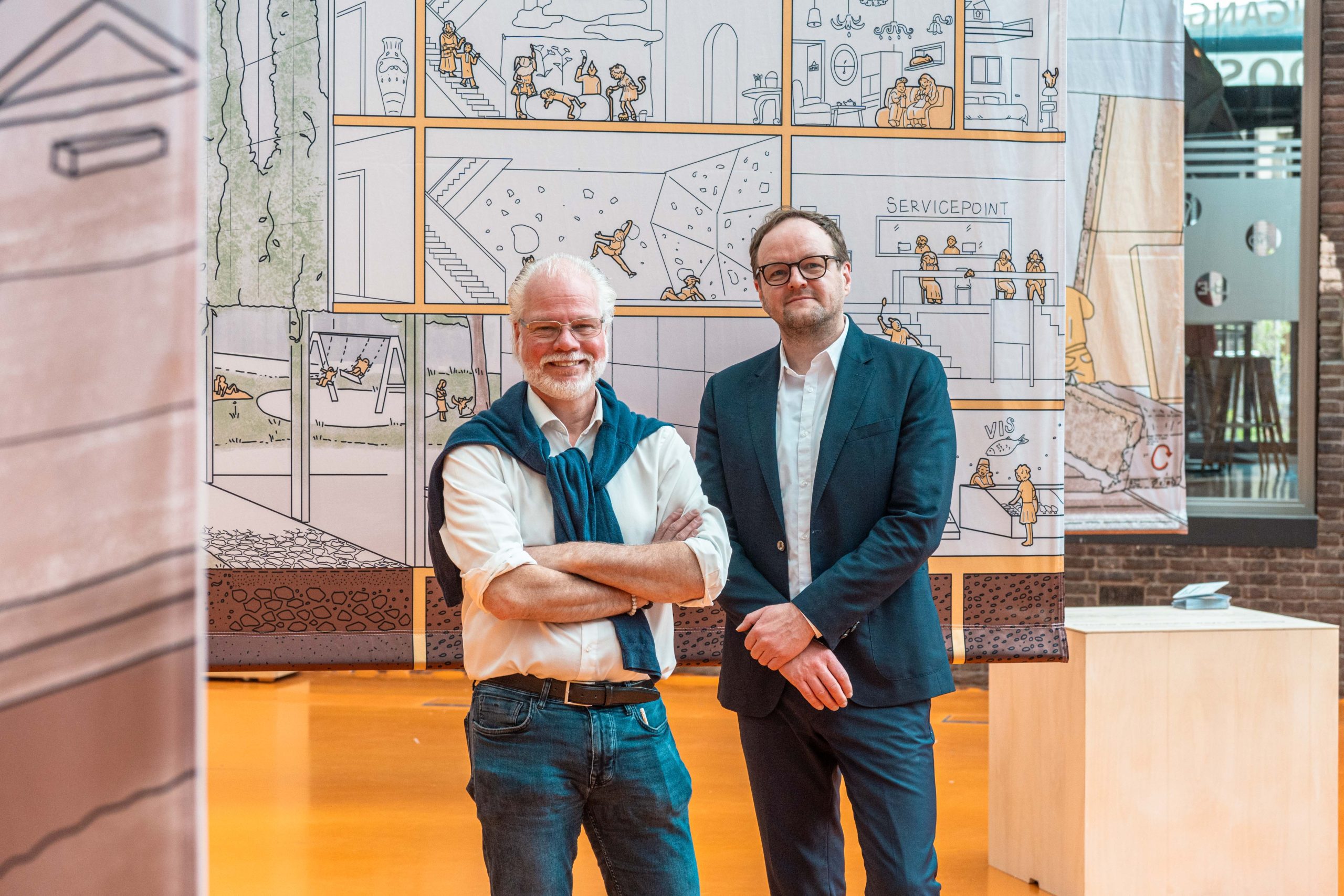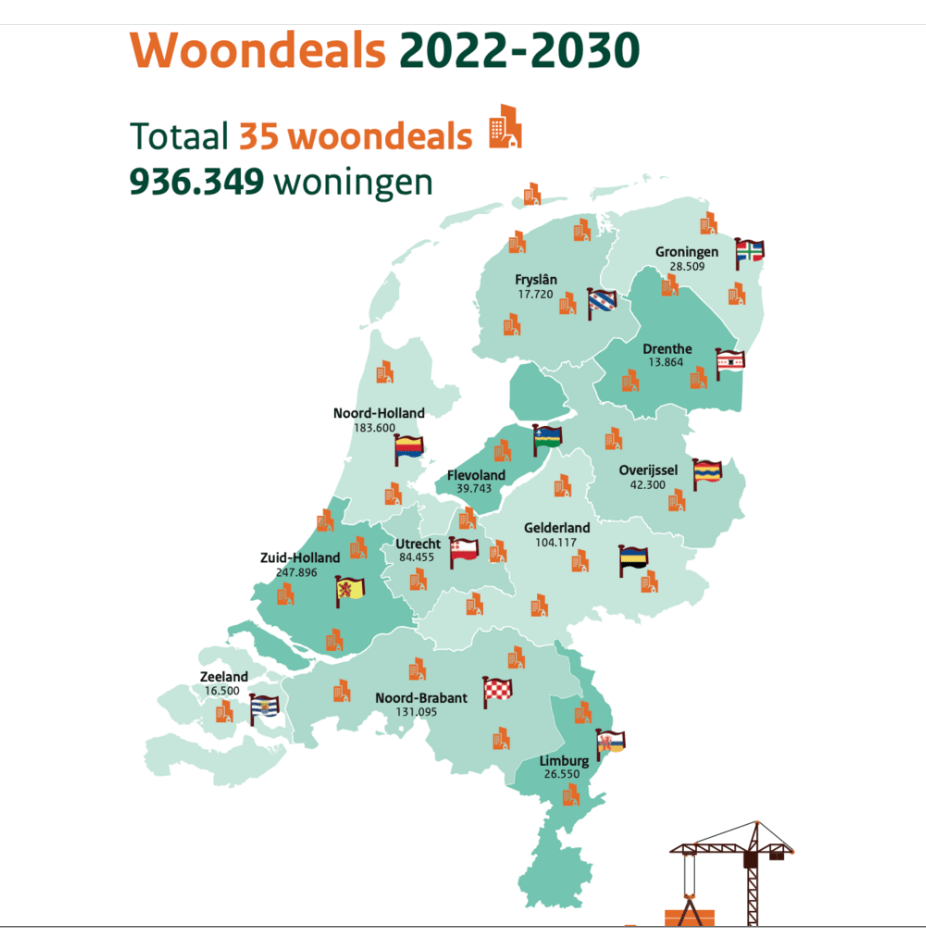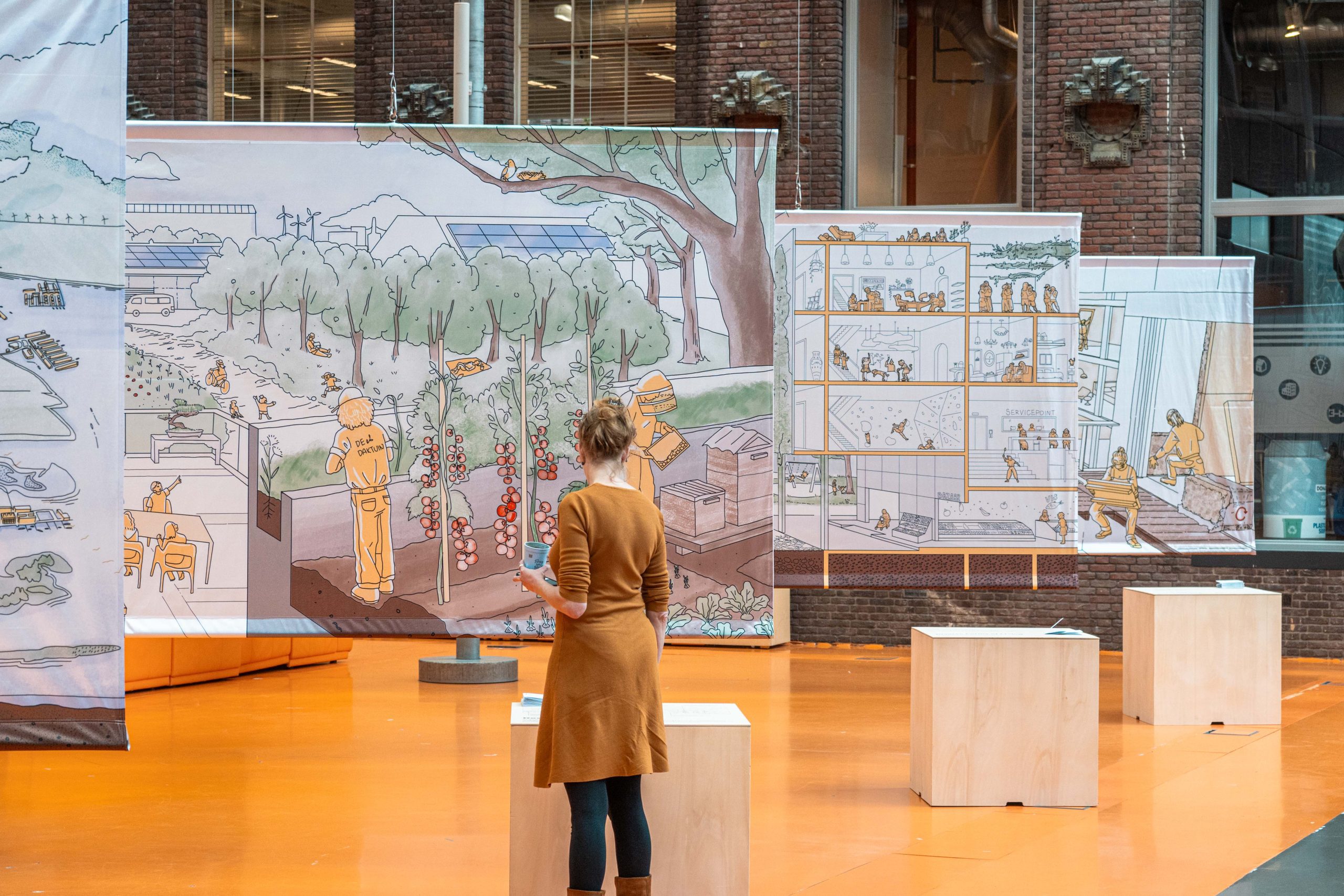It is perhaps the most pressing issue in the Netherlands: the housing crisis. The TU Delft Vision Team Wonen has come up with some stimulating ideas in the form of a temporary exhibition.
Young Architecture alumni gave their vision on housing in the temporary exhibition Room for Housing in the Faculty of Architecture, april 2024 (Photo: Thijs van Reeuwijk)
‘The housing crisis is actually an opportunity,’ argues the TU Delft Vision Team Housing, ‘an opportunity to create a sustainable and long-term healthy living environment.’ A team of 10 researchers from various faculties worked for a year and a half on the ‘Ruimte voor wonen‘ (space for housing) report which was presented on Tuesday, 2 April ’24.
The housing crisis is not an isolated issue, the researchers write, so the solutions they propose should not only create housing, but should also help solve other crises. They mention climate adaptation, demographic change, the energy transition, circularity, industry, agriculture, infrastructure and nature.
Solutions to the housing crisis are displayed on four large canvases, each two by six metres, which are the work of graduates from the Faculty of Architecture and the Built Environment. They are a temporary exhibition in the East Conservatory of the Architecture building.
- The exhibition can be seen from 2 to 16 April and from 22 to 29 April.
The canvases show different perspectives on the housing crisis:
- Future-proof spatial plans that make better use of promising sites;
- Resilient neighbourhoods that create the physical and social conditions for long-term, comfortable living and working environments;
- Diverse housing types that meet different housing aspirations and needs.

Researcher Ulf Hackauf and Dr Gerard van Bortel, both members of the Faculty of Architecture and the Built Environment, led the Vision Team. Hackauf looks back on the presentation.
The Team’s advice is wide-ranging and could be of interest to the Government, provinces, municipalities, housing associations and so on. Did you see representatives of them all at the presentation?
“Certainly not all of them, it was more of an internal discussion evening. I saw people from the Ministry of the Interior, the municipality of Delft, and the Woonbond (national tenants’ association, Eds.). Afterwards they asked if we could give the presentation in their offices, and we agreed to do so.”
‘We are faced with a construction task similar to the reconstruction after the Second World War’
You point to industrial areas as possible sites for housing developments. How can you turn them into attractive neighbourhoods?
“This is an idea of my colleague Alex Wandl. He identifies industrial sites, office parks and other ‘in-between’ areas as low-density places that are close to cities and have the potential to combine activities with housing. The transformation from industrial to residential or mixed use is becoming more common. One example is Buiksloterham in Amsterdam-Noord, a former industrial area that is now being transformed into a residential area with all kinds of activities. Where there used to be shipyards, apartments are now selling for over a million euros. The Binckhorst in The Hague shows a similar picture.”
Families form or break up. How can you adapt housing to changing life stages?
“A multi-storey residential building can be made adaptable by including a number of access doors and by designing the load-bearing structure in such a way that the walls can be moved. Where this becomes more difficult is where showers, toilets and kitchens are built. How to lay pipes in such a way that the interior remains adaptable is still a puzzle.”
Do you see a role for young architects in these new forms of living?
“Definitely. In the 1980s there were still housing competitions with building guarantees. For example, there was the commission for youth housing on the Kruisplein square in Rotterdam. Three students from TU Delft won the competition. This was the beginning of what was to become Mecanoo (1983, Eds.). Francine Houben has continued the firm and Dick van Gameren, one of the partners, is now the Dean of Architecture. Mecanoo is now a large, internationally renowned firm, but it started with a competition for youth housing that was actually built and is still there. That’s how it works. Students should be given a chance. We should have more competitions like this. And then reward them not with a bunch of flowers and a sum of money, but with a building.”
How does this report help break the deadlock in construction?
“We are faced with a construction task that is similar to the reconstruction work after the Second World War. At that time, the Bouwcentrum (in Dutch) in Rotterdam was set up as a knowledge centre for clients, builders, designers and engineers. We need something like that again now, but that also supports collective building.”
Can you give me an example of collective building?
“I was in Hamburg last summer, and the municipality there has set aside a number of plots in the middle of the harbour area for building groups. This is a group of people who get together as clients for a residential building. Friends of mine, a family with two children, live there in a relatively small space. But they have a communal area where they can cook or give parties. There is a theatre, a café, guest rooms and five roof terraces. It then doesn’t matter if you live in a bit of a small place yourself. Then I thought that this should be done in the Netherlands too. Then it helps to have the financial and legal knowledge you need in a Housing Knowledge Centre.”
- Visit the Vision Team Housing’s presentation page.
- Visit the Room for Housing exhibition in the East Conservatory of the Architecture building, up to 29 April.
- Also read this letter to the editor: ‘Design a new work culture in architecture’

Do you have a question or comment about this article?
j.w.wassink@tudelft.nl


Comments are closed.